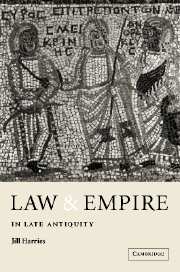Book contents
- Frontmatter
- Contents
- Preface
- Introduction
- 1 The law of Late Antiquity
- 2 Making the law
- 3 The construction of authority
- 4 The efficacy of law
- 5 In court
- 6 Crime and the problem of pain
- 7 Punishment
- 8 The corrupt judge
- 9 Dispute settlement I: out of court
- 10 Dispute settlement II: episcopalis audientia
- Conclusion
- Bibliography
- Index
- Frontmatter
- Contents
- Preface
- Introduction
- 1 The law of Late Antiquity
- 2 Making the law
- 3 The construction of authority
- 4 The efficacy of law
- 5 In court
- 6 Crime and the problem of pain
- 7 Punishment
- 8 The corrupt judge
- 9 Dispute settlement I: out of court
- 10 Dispute settlement II: episcopalis audientia
- Conclusion
- Bibliography
- Index
Summary
What is a tree? For lawyers, and litigants with trees on their land, this question could be important. ‘Most of the ancients’, according to the Severan legal commentator, Ulpian, thought that vines were trees, likewise ivies, reeds and willows. A plant could not be a tree unless it had developed roots and ‘that also is deemed to be a tree, the roots of which have ceased to live’ or which, if uprooted, could be put back again or transplanted. The stock of an olive was also a tree, whether or not it yet had roots. The roots were not included in the term ‘tree’.
Ulpian was a learned and prolific jurist, an expert commentator on law whose interpretations carried authority. His discussion of what a tree was is extracted from a work, not on arboriculture, but on detailed matters of law. The object of the discussion was to ascertain when, or in what circumstances, an action for the secret felling of trees could be brought. In order to define the office, legal experts had to deliberate about what a tree was, how ‘felling’ should be defined (that was, not bark-stripping, cutting with a saw or pulling up by the roots), who was liable, what was due to the owner(s), what was meant by ‘secret’ and whether or not an alternative action, for theft, could also be brought.
- Type
- Chapter
- Information
- Law and Empire in Late Antiquity , pp. 1 - 5Publisher: Cambridge University PressPrint publication year: 1999

